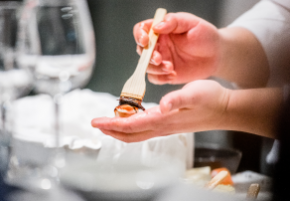- About
- Programs
- Campus Life
- Career Services
- Admissions
- News & Events
- Alumni
Key Differences Between Flour and Bread Flour for Baking
Discover the difference between flour and bread flour, how they affect baking, and when to use each. Choose the right one and perfect your baking today!
Key Takeaways
- Flour and bread flour differ in protein levels, gluten development, texture outcomes, and how they absorb and hold moisture.
- Bread flour is best used for yeast-based recipes like breads, pizza dough, bagels, and rolls.
- All-purpose flour works well for cakes, cookies, muffins, pie crusts, and pancakes.
Some ingredients are so fundamental to cooking that it's difficult to imagine how many dishes would be impossible without them. Salt, water, oil, eggs, and flour belong in this category as essential in every kitchen.
Flour is quite neutral—mild in flavor and rarely used on its own. However, despite appearing to be a simple pantry staple, flour comes in various types.
That's why it’s important for aspiring chefs to understand the difference between flour and bread flour so they can make the right choice for the best possible results.
What Is Flour?
Flour is broadly defined as the finely milled meal of grain, usually wheat, used in baking and cooking.
In everyday usage and recipes, when we refer to "flour," we typically mean all-purpose flour (unless specifically stated otherwise). This type of flour, as its name suggests, is arguably one of the most versatile.
It is a refined wheat flour made from a blend of hard and soft wheat that results in a moderate protein content suitable for a wide range of baking applications.
What Is Bread Flour?
Bread flour is a type of wheat flour specifically created for yeasted breads and similar recipes. It is primarily milled from hard wheat, such as hard red spring or hard red winter wheat.
Dough made with this type of flour tends to be more resilient and stretchy, which is precisely what you want for lofty, chewy bread. The gluten network gives structure to artisan loaves, pizza crust, bagels, and other baked goods that need to hold their shape and rise tall without collapsing.
Key Differences Between Flour and Bread Flour
All-purpose flour and bread flour are the most common and widely used types of flour. However, they differ in a few aspects.
Protein content and gluten formation
The primary difference between bread flour and all-purpose flour is found in their protein content. All-purpose flour generally contains about 9% to 12% protein, whereas bread flour comprises around 12% to 14%.
A higher percentage implies that more potential gluten can form. That's the network of proteins that develops when flour mixes with water and is agitated by stirring or kneading. Gluten is responsible for the elasticity and structure of the dough.
Therefore, the additional protein in bread flour gives the dough more gluten strength, while all-purpose flour produces less gluten, which is acceptable and even desirable in some situations.
Texture and baking results
Because of their differences in protein and gluten, the two flours also produce noticeably different textures in finished baked goods.
Bread flour is famous for yielding a chewy, airy crumb in breads. Those qualities come from the stronger gluten development compared to all-purpose flour, which tends to produce a softer, more tender crumb.
If we were to make the same recipe of a loaf of bread twice—once with bread flour and once with all-purpose flour—it'll be easy to notice which is made with what. The loaf with bread flour will likely rise higher and have a more open crumb or larger air holes, whereas the loaf made with all-purpose flour will likely be more tightly crumbed with smaller pockets of air.
Absorption and hydration
The two types of flour differ in their water absorption capacity. Bread flour, with its higher protein content, binds with water more readily, often requiring more water to achieve the same consistency as all-purpose flour.
This higher absorption makes bread flour ideal for high-hydration doughs, resulting in a firmer, drier dough that rises upwards rather than spreading outward. In contrast, all-purpose flour dough tends to feel wetter and softer, often spreading more and requiring a pan for support when hydration is high.
When to Use Bread Flour vs. All-Purpose Flour
To choose the best option for your recipes and achieve the desired results, you need to be aware of all the features and differences between bread flour and all-purpose flour.
Best uses for bread flour
Bread flour is the perfect choice for recipes that require a strong gluten network and structure. Some of the most common baked goods where bread flour is preferred include:
- Artisan boules
- Sourdough loaves
- Bagels
- Rye bread
- Chewy, pizzeria-quality crusts
- Pretzels
- Dinner rolls
- Hamburger buns
- Parker house rolls
- Cinnamon rolls
- Sticky buns
Best uses for all-purpose flour
All-purpose flour is often the default choice for:
- Cakes
- Cupcakes
- Cookies
- Brownies
- Muffins
- Banana bread
- Zucchini bread
- Pie Crusts
- Tart shells
- Puff pastry
- Biscuits
- Pancakes
- Waffles
Substituting bread flour and all-purpose flour
There may be times when you only have one of these types of flour on hand, and that's okay. The guidelines above are general preferences, not strict rules—substitution can work when needed.
All-purpose flour and bread flour can often be substituted for each other—your recipe will still turn out tasty and recognizably correct. However, you will notice differences in the dough behavior and final texture, so a few adjustments can help improve the results.
Substituting bread flour with all-purpose flour
If a recipe calls for bread flour but you only have all-purpose flour, you can substitute it at a 1:1 ratio. The outcome may be slightly softer and less chewy than intended.
To compensate, focus on developing the gluten in the dough. Kneading or mixing the dough a little longer can help strengthen the gluten network that all-purpose flour might lack. Another trick is to let the dough rest longer, allowing the gluten to develop gradually.
Because all-purpose flour doesn't absorb as much water as bread flour, a good rule of thumb when using all-purpose flour instead of bread flour is to reduce the water by about 15–30 grams for every 500 grams of flour. Holding back some liquid and mixing thoroughly can help achieve a dough consistency closer to what bread flour would provide.
Substituting all-purpose flour with bread flour
If a recipe calls for all-purpose flour but you only have bread flour, you can make the swap, but be mindful of the textural shift.
For bread or pizza crusts, using bread flour often enhances chewiness and structure. However, in delicate baked goods like cakes, biscuits, or cookies, it can make the texture tougher or denser than intended. The higher gluten content that benefits bread can be too strong for tender cakes and different pastries, sometimes resulting in a more rigid or chewy outcome.
To soften the effect, you can replace a couple of tablespoons of bread flour with cornstarch to lower the overall protein content, creating a makeshift lower-protein flour. Additionally, avoid overmixing, as bread flour develops gluten more quickly.
That said, some bakers and pastry chefs intentionally use bread flour in cookies or other baked goods to create a chewier texture. Ultimately, it comes down to the result you’re aiming for.
Perfect Your Baking Skills
Perfecting your culinary skills comes down to understanding your ingredients. Learning how to select the right type of flour, handle it properly, and pair it with other ingredients is one of the most important parts of it.
At Culinary Arts Academy Switzerland (CAAS), students learn that, among many other things, through our Bachelor of Arts in Culinary Arts or our one-year Diploma in Pastry and Chocolate Arts. However, understanding ingredients is only part of the process—knowing how to think and work creatively with them is just as important.
This balance of knowledge and creativity is something our students refine through projects like the Food Development Project, delivered in partnership with MANE, a leading fragrance and flavor company. Each semester, MANE challenges our students to tackle real industry needs, encouraging them to think beyond recipes and develop innovative solutions.
One such challenge focused on gluten-free baked goods—and one of our student winners, Madhav Dayal, demonstrated this perfectly by creating his own gluten-free flour blend using almond meal, tapioca starch, corn starch, rice flour, and guar gum.
This is just one example of how CAAS prepares students to master the culinary craft, innovate, adapt, and understand the business side of food development. Much like how flour is the basis of so many recipes, the well-rounded education we offer can be the foundation of your culinary career.
Frequently Asked Questions
Is bread flour healthier than all-purpose flour?
Bread flour contains more protein than all-purpose flour, but this difference doesn't significantly impact overall health.
Does bread flour expire faster than all-purpose flour?
Not really—as long as both are kept in a cool, dry place, they tend to last around the same time, usually up to a year.
Interested in learning pastry arts? Discover our Swiss Diploma in Pastry Arts program.


























